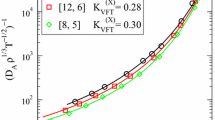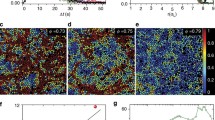Abstract
Glass transition involves a many-body interaction and relaxation process. The split of relaxation spectrum and the extremely slow dynamics bring into considerations of non-linearity and non-equilibrium. Some of our recent findings in two measurable colloidal systems are reviewed, one with a simple attractive interparticle potential and the other with a competitive (repulsive vs. attractive) inter-particle interaction. With an approach from interaction potential changes to the corresponding structural and relaxation responses, along the path of reaching the final equilibrium, we illustrate some interesting physics in glass formation process. Also, some reviews on the popular glass transition theories are made to remind readers to avoid artifacts and misinterpretations.
Similar content being viewed by others
References
Yuan G, Cheng H, Han CC. Polymer, 2017, doi: 10.1016/j.polymer. 2017.02.066
Rice SA. Phys Rev, 1958, 112: 804–811
Zhao C, Yuan G, Jia D, Han CC. Soft Matter, 2012, 8: 7036–7043
Zhao C, Yuan G, Han CC. Macromolecules, 2012, 45: 9468–9474
Luo J, Yuan G, Zhao C, Han CC, Chen J, Liu Y. Soft Matter, 2015, 11: 2494–2503
Yuan G, Luo J, Han CC, Liu Y. Phys Rev E, 2016, 94: 040601
Verduin H, Dhont JKG. J Colloid Interf Sci, 1995, 172: 425–437
Miller MA, Frenkel D. J Chem Phys, 2004, 121: 535–545
Zhao C, Yuan G, Han CC. Soft Matter, 2014, 10: 8905–8912
Zong Y, Yuan G, Han CC. J Chem Phys, 2016, 145: 014904
Zong Y, Yuan G, Zhao C, Han CC. J Chem Phys, 2013, 138: 184902–184907
Pham KN, Petekidis G, Vlassopoulos D, Egelhaaf SU, Poon WCK, Pusey PN. J Rheol, 2008, 52: 649–676
Vogel W. Phys Z, 1921, 22: 645–646
Fulcher GS. J Am Chem Soc, 1925, 8: 339–355
Tammann G, Hesse W. Z Anorg Allg Chem, 1926, 156: 245–257
Williams ML, Landel RF, Ferry JD. J Am Chem Soc, 1955, 77: 3701–3707
Ferry JD. Viscoelastic Properties of Polymers (3rd Edition). New York: John Wiley and Sons, 1980
Gibbs JH, DiMarzio EA. J Chem Phys, 1958, 28: 373–383
Adam G, Gibbs JH. J Chem Phys, 1965, 43: 139–146
Kauzmann W. Chem Rev, 1948, 43: 219–256
Zwanzig R. J Chem Phys, 1960, 33: 1338–1341
Zwanzig R. Phys Rev, 1961, 124: 983–992
Mori H. Prog Theor Phys, 1965, 33: 423–455
Götze W. Complex Dynamics of Glass-Forming Liquids: A Mode-Coupling Theory. Oxford: Oxford University Press, 2008
Acknowledgments
This work was supported by the US National Science Foundation (DMR-1508249) and the National Natural Science Foundation of China (21474121). The identification of commercial products does not imply endorsement by the National Institute of Standards and Technology nor does it imply that these are the best for the purpose.
Author information
Authors and Affiliations
Corresponding author
Rights and permissions
About this article
Cite this article
Yuan, G., Han, C.C. Glass transition: from interaction potential changes to the corresponding structural and relaxation responses along the path of reaching the final equilibrium. Sci. China Chem. 61, 46–53 (2018). https://doi.org/10.1007/s11426-017-9144-4
Received:
Accepted:
Published:
Issue Date:
DOI: https://doi.org/10.1007/s11426-017-9144-4




